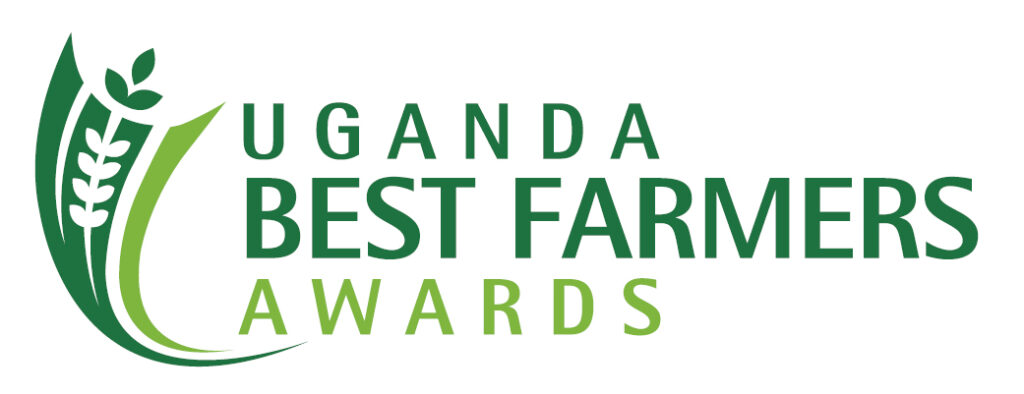
By Umar Nsubuga
The cocoa aroma welcomes one to Lilian Kobugabe Rwomushana’s 100-acre farm. But Rwomushana, 42, has not always farmed on a commercial scale. She started as a dairy farmer with few cows.
“Dairy was my life,” she says. Dairy took care of all her needs. Rwomushana says it was in the early 2016 when a friend opened her eyes to the profitability of commercial farming. She gave it a try and has not regretted that decision. The returns are consistent compared to cattle where she experienced ups and downs.
Valour Farm her farm name is the centre which is located in Kyenjojo district, about 9km off Kyenjojo-Fort Portal- road, Bibuye village Kihura sub-county. Rwomushana, and her family own this organic farm.
Rwomushana, a professional teacher never taught, upon graduating with a Bachelor of Arts with Education, she immediately enrolled for a master’s in International Relations and Diplomacy.
“While others are enjoying outings over the weekends, I spend my time working here at the farm,” she says.
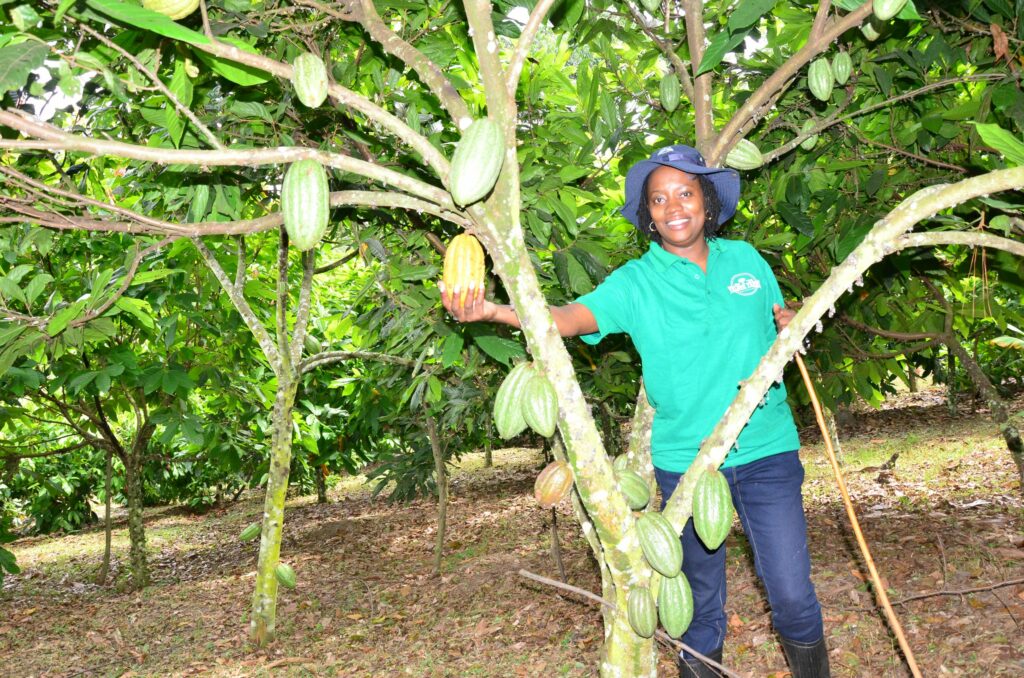
How she started
The farm started in 2016 and she has been buying land in bits, but Rwomushana grew up seeing crops and animals but her passion was not farming and her parents were leaving in Nakasero, Kampala. “My father retired when I was in Senior Six, so after retiring he went into farming and I saw everything was coming from farming,” she recalls.
During her Senior Six vacation, she got interested and this was how her passion for farming began. “I realised that farming was a money bank because my father used to sale different produce and gets money”, she said.
“So, when I graduated, I dreamed of venturing into farming and I shared the idea with my husband. Fortunately, my husband had bought land (20 acres) in Kyenjojo where we are, and we started with planting trees,” she says.
Rwomushana says she visited National Forestry Authority (NFA) and husband at Namanve in Mukono and they were showed all the trees they could grow.
Rwomushana planted pine on 15 acres but only ten acres came out, “we used to visit the village but neighbours were growing others crops like maize”, this wasn’t our interest”, she explains.
Rwomushana says when they started to plant, maize, the investment was high, but the returns were low. “We bought treated seeds and fertilisers and the produce was good, but the profit was low. We were learning from the mistakes,” she says.
According to Rwomushana they used oxen and a tractor even they used to get workers at the farm, she says this was still learning the situation. By that time the project was financed by personal savings up to now.
The farm sits on 100 acres, with cocoa on 10 acres, coffee 15acres, macadamia nuts 5 acres, pine 4 acres, eucalyptus 6acres, mahogany 3acres, terminalia 10 acres and other acres are cows.
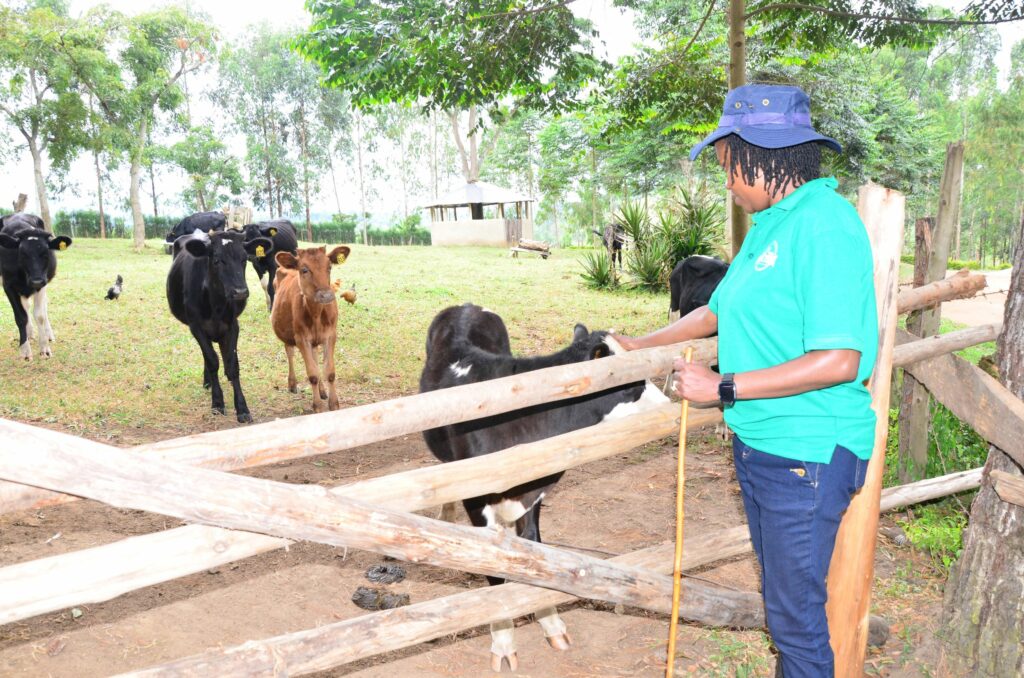
Cocoa
When Rwomushana set up her cocoa farm, many scoffed at her because at the time cocoa was not grown in the district.
She ventured into cocoa farming on the advice of a friend, Tom Mukwaya, who had attended a sensitisation workshop about the crop’s benefits.
She started with six acres and her cocoa farm has grown over the years and now sits on 10 acres.
Richard Twebaze a trader in Kyenjojo town says Rwomushana is one of the big cocoa producers in their area
The proper measurements
For any farmer who is interested in cocoa growing he or she must know that the seedlings take six months to grow before they are transplanted at the onset of the first rains.
Rwomushana says the spacing is important and the ideal is 3m x 3m (10ftx10ft) and the planting hole 2ft x 2ft deep and wide. “Manure can be applied. Each acre takes 435 plants,” she advises.
Taddeo Mugisha a resident and who has just started farming says he started planting trees because he was advised by Rwomushana to first plant trees because cocoa needs a shade, and he intercropped with bananas and coffee trees.
It is important to prune the cocoa tree during the early stages. Cocoa requires filtered sunlight through trees. Sustainable management of shade trees like Musizi, grumixana, sapote and breadfruit allows the farmer to earn extra income from timber and fruits. It also maintains or increases the cocoa bean production each year.
Rwomushana visits all farmers in the district to advise them, “When you care for your cocoa plant it starts flowering and putting on pods at two-and-half years and ripens in the third year,” she says.
According to Rwomushana many farmers need technical information, for example, a cocoa tree reaches peak production in 10 years and will continue producing pods for an additional 12-13 years.
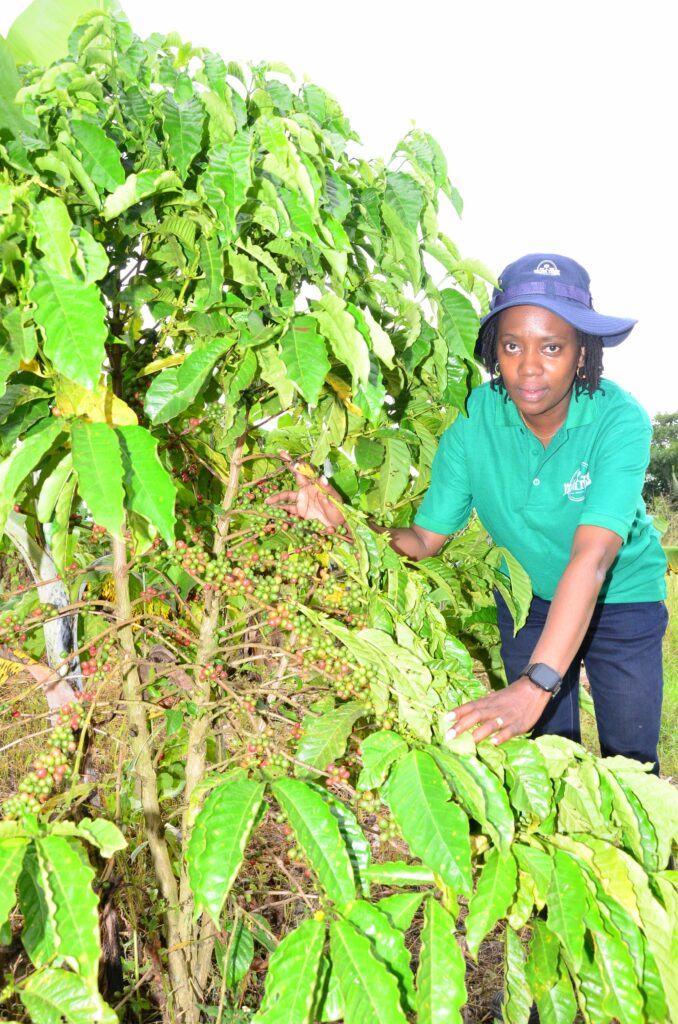
Challenges with cocoa
The fact that cocoa is edible exposes it to attack from squirrels, monkeys and baboons. Rwomushana gives residents free dogs which they use to patrol their plantations, but it is hard to monitor the movements of vermin, given the vast acreage of the plantation.
Humans also eat the ripe cocoa. Like other crops, cocoa is attacked by pests and diseases, which cause swellings and patches on the stems.
The affected plants are cut down and burnt. Such attacks affect yields by over 60%. Rwomushana says the biggest challenge that cocoa farmers are faced with is the fluctuation of prices and exploitation by other middlemen.
Sometimes the situation is further complicated by poor harvesting methods, which are killing the market and vagaries of weather, such as drought, which affects yields.
Farmers are also looking to the Government to help them fight cocoa disease and pests, which include cocoa capsides, scale pests, aphids, snakes and squirrels.
With the cocoa boom on, theft of cocoa pods is rampant, with the thieves targeting cocoa trees located along the farm boundary or near the road.
Livestock farming
Indeed, looking under the shades of the pine and eucalyptus trees, there are over were 15 dairy cows. Her livestock business was the second project in 2016, when she bought first bulls on a buy and sell basis. The herd increased when she bought two dairy cows
The dairy cows in her stock then would give her a total of 14 litres of milk a day.
Rwomushana started with two sets of oxen, which she bought from Bukedea each at sh1.5m
Seven years down the road, the dairy project has registered a remarkable progress from the original two animals to 25 cows but 14 are claves.
There is also a section of bulls and are 50 but all the dairy are pure friesian and are housed in livestock shades.
On average a friesian cow at Rwomushana’s farm, is capable of yielding 8-12 litres of milk per day. The daily yield is about 60 litres. “In the morning we get 40 litres, 30 of which are sold and the remaining 10 are for the calves. In the evening, they yield 20 litres which are given to the calves, dogs for security and workers,” she explains.
According to Rwomushana whose clientele are community people and she uses farm motorcycle to move around with a litre sold at sh1,000.
She earns a gross of sh50,000 from milk sales per day and around sh1.5m a month.
Rwomushana says fluctuating milk prices also affects production. “Sometimes a litre of milk may be as low as sh500.
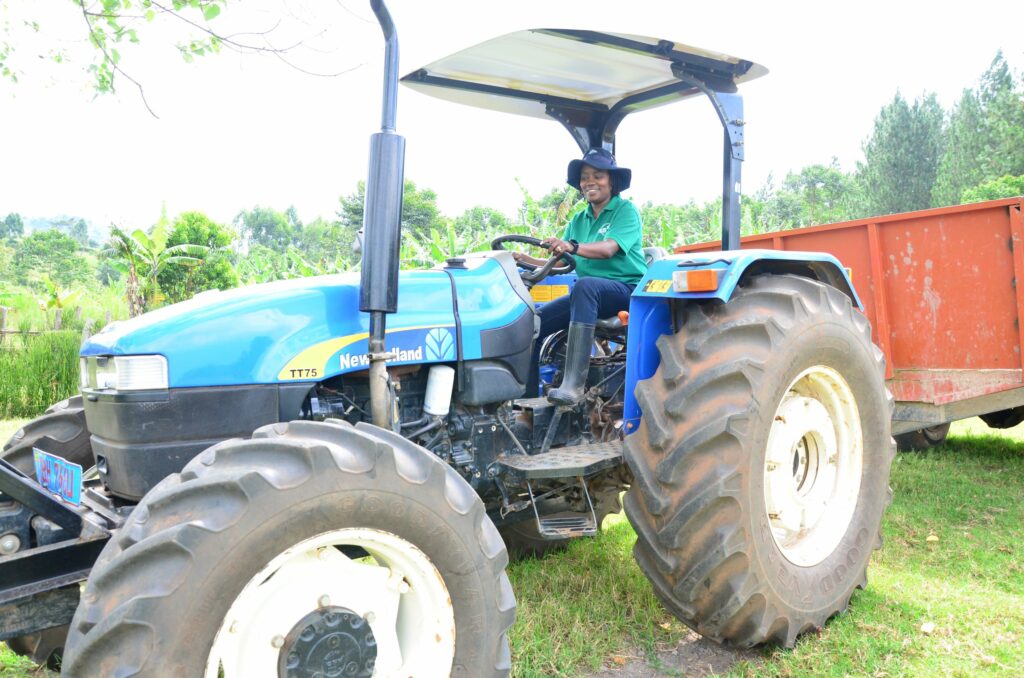
Care for the animals
Rwomushana says the first thing she did at her farm was to make kraals for the various cow breeds she has and also put them under different cattle keepers.
She explains that her farm houses for friesians and the bulls are far from each other, which she allocated to different managers since they need different care.
The manager of Rwomushana’s farm, Wilfred Mulingoki says he ensures that all the cows drink water thrice a day. They are also dewormed every two months and vaccinated against diseases.
Mulingoki explains that as soon he realises that any cow is affected, he calls a veterinary doctor to treat it so that it does not spread the disease to other animals.
The bulls feed on grass on the farm. Besides, the paddock system is also used during the dry season.
Macadamia nuts
In 2021, Rwomushana visited a farmer who had a macadamia nursery, after realising the nut is in demand, she also decided to add it to her farm.
She planted 750 seedlings each costing sh10, 000, she says she decided to start because, it was new in the region.
According to Rwomushana the nut takes two years on a nursery bed and four years before fruiting.
“When I realised that it has two seasons in a year, I decided to start this project as well, I had also done research on the high value the nut has,” she explains.
The coffee gardens
Rwomushana says it’s her second season since she went into coffee farming, but she says many coffee farmers have failed to understand the secret behind a coffee crop. But, ideally after the first harvest, each coffee plant is capable of sustaining itself in terms of nutrients,” observes Rwomushana.
“What will make my coffee garden distinct from others in few years is just a concept I obtained from my parents because they were also coffee farmers,” Rwomushana says.
She says sometimes, the yields depend on the weather conditions. After harvesting the coffee beans, they are put in a drum full of water. “All the coffee beans that sink are deemed good while the ones that float are of poor quality,” she says.
Those that float are removed, dried separately and sold at a lower price than the good ones. On the other hand, the good coffee is taken to a pulping machine, where the red skin is removed.
After pulping, the coffee is dried on raised beds. Rwomushana says the prices fluctuate between sh3,000 and sh4,000 per kilo.
She says so far she has harvested 10 bags of 100 kg this season from the 15 acres.
Tree farming
In 2016, Rwomushana and her husband started their initiative of planting trees starting with pine trees, some trees dried.
As years went by, their trees grew. Today, she has 4 acres of pine, 6 acres of eucalyptus, 3 acres of mahogany and 10 acres of terminalia.
Rwomushana says tree growing can be profitable but one of the challenges is ringbark disease which attack pine trees and they normally attack them right from the nursery.
The plant starts to dry from the tip to the bottom or colouring from green to yellow and eventually dies.
Rwomushana says when her trees are attacked, she sprays them using Nimrod chemical. “Apart from few challenges growing of trees especially pine can be profitable. It’s also an investment where you keep your money growing,” she says
She says between five to six years, a single tree can fetch about sh200,000 – sh250,000.
Earnings and expenses
From all the enterprises, the farm earns a gross of sh32-40m per month. From this, the farm retains around sh4m after deducting expenses.
The biggest expense goes to farm labour. She says she employs four permanent workers at the farm. “I pay sh650,000 monthly to the workers,” she says. Additionally, she gives them accommodation, food and health care.
“I make expenses on transporting produce from the farm to the main road and on buying some chemicals, but all these do not go beyond sh2m per month,” she says.
Knowledge
How I increase my knowledge, I think social media has been a blessing ever since I joined farming am now on many different forums of different ventures like now am part of a group called cattle generation it has veterinary doctors, it has suppliers, it has people of drugs so people share different ideas, they do farm visits, and I have got an opportunity to learn, I even learnt how cows behave, and this helped me whenever it behaves in a different ways I can know even when it’s time to call a veterinary doctor I do so!
Mechanisation and irrigation
Rwomushana has a tractor, which cost over sh100m, but she says, she is still paying a loan. “It’s backed by different ploughs to ease farm work.
When she saved some money, she decided to top up with a loan from a bank.
Rwomushana set out to establish water source. She has drilled two wells within the farm. “I spent close to sh4m to drill the two wells and besides I invested some other sh2m to buy the connecting system to the tanks,” she says.
She uses the water for all the activities on the farm with the help of a generator pump
“Biosecurity helps to keep out endemic diseases which have serious economic implications. However, in case of an outbreak, confine the affected animals to a small part of the farm for easy management,” Rwomushana advises.
Achievements
“Making an impact to my community is enough to me. I really feel good when people come and admire and also learn,” she says.
Challenges
Rwomushana says that she still needs a lot of money to operate the farm and yet she does not get support from anywhere, apart her husband and her personal savings.
-Poor road network. The farm is less than 10kms from the main Kyenjojo- Mubende- Kampala Road but it takes an hour to drive there. This discourages would be buyers of our farm produce and increase operation costs.
-The area in which the farm is situated is not on the National Electricity grid. This makes mechanisation very costly due to high fuel prices.
-Fluctuating milk prices hinder smooth running of the projects since there is no standard earning.
-Unfriendly bank interest rates especially for agricultural related loan facilities, Rwomushana says this affects farmers develop with loans when needed.
-The human resource turnover rates retard progress as the farm keeps in a training cycle.
Plans
-Have improved beef breed that is fast growing, resistant and environment acclimatised.
-Have high yielding diary breed.
-Have a value addition schedule for the diary section and cash crops (cocoa, coffee and macadamia nuts) with proper branding.
-Build weather and pest proof storage facilities.
-Become a recognised Agro tourism centre open for leisure and research.
Workers
Rwomushana says, she has three reliable workers, the rest keep changing from between a year and two years. “Most workers in the village are target workers, some come saying their dream is to build a house with iron sheets, when they achieve their goals, they leave”, she explains.
Physical security
According to Rwomushana her physical security is canine unit, she also has dogs that guard her farm.
Family
Rwomushana says her husband is her partner in the business/farm. “We take most if not all decisions as a unit. When he gets free time off his job he is always at the farm. He is very passionate about cattle and trees. The children love the farm and enjoy the holidays at the farm”, she says.
What others say
Patrick Rwomushana, Husband
I always offer advice to my wife and her workers on how best they can run the farm. I do a lot of visiting other farms and what I appropriate to apply on Lilian’s farm we sit and discuss the way forward.
David Tanga a friend
Rwomushana is someone who loves to see people economically empowered. Not only does she allow people to visit her farm where she teaches them modern farming methods, but she is also always on the different platforms giving people tips to venture into agriculture.
Grace Kiiza a neighbour
I have known Rwomushana since she started a commercial farming, she is a hardworking woman, down-to-earth, social and passionate about agriculture. I am not surprised she has been able to this much in few years.





